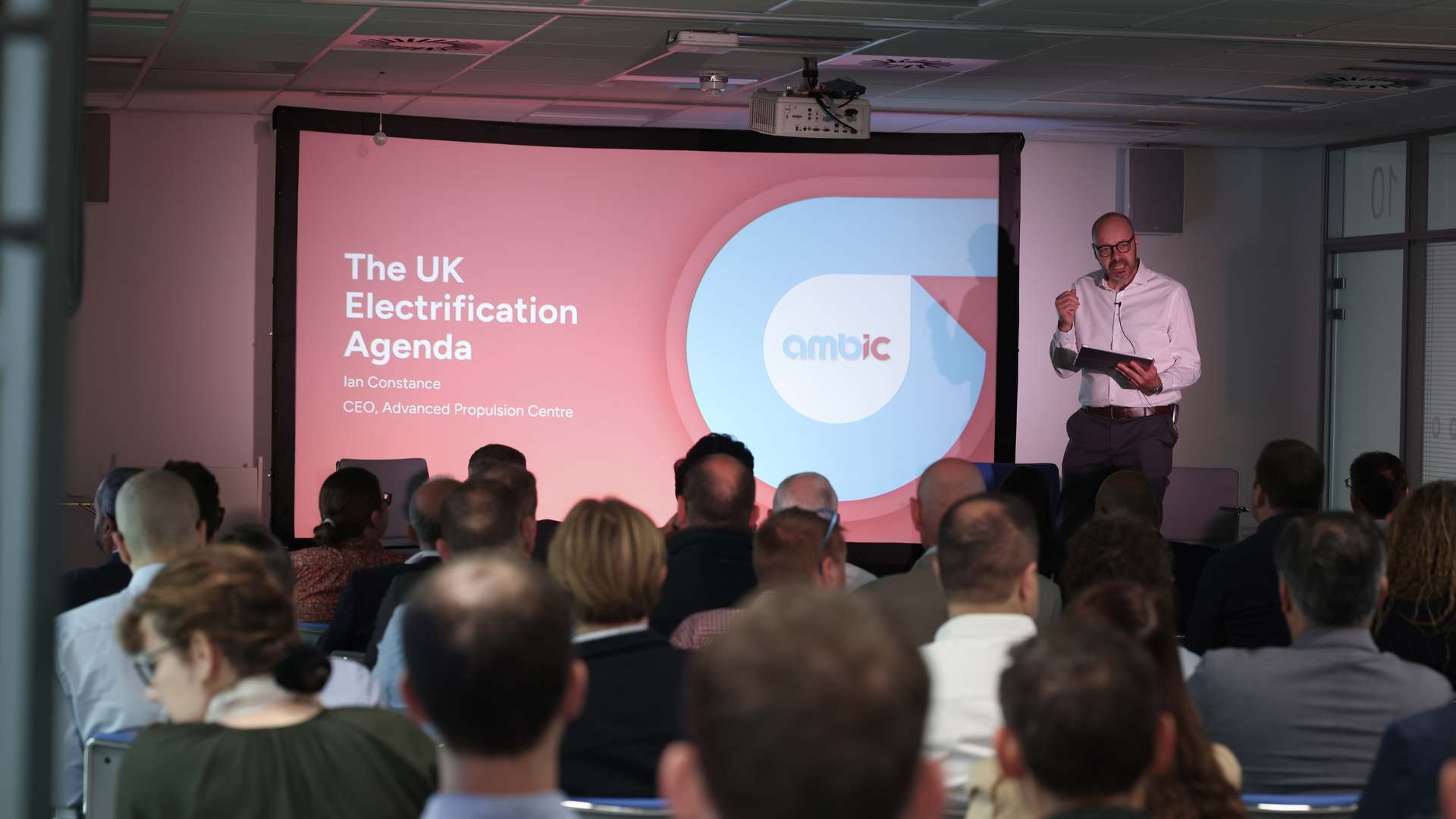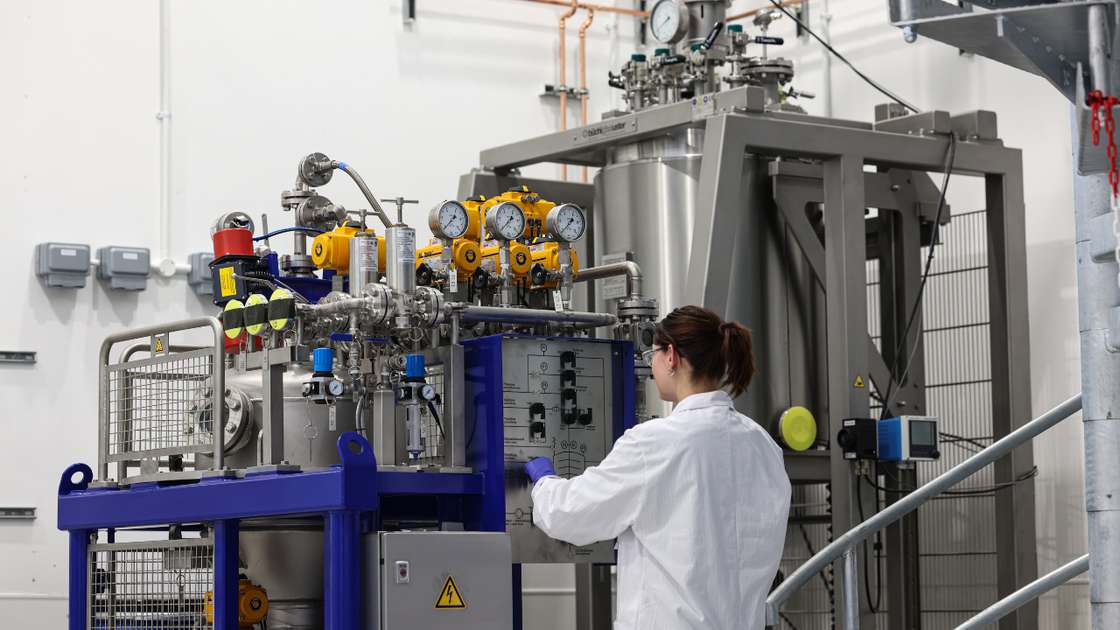Supercharging UK battery innovation: Accelerating materials scale-up with AMBIC
How can the UK stay ahead in the global battery race? Industry leaders came together to explore the path to electrification and innovation.

Chief Technologist

The UK’s journey towards electrification is accelerating rapidly, but without swift innovation, sustained investment and industrial-scale capabilities, we risk falling behind in a fiercely competitive global market.
At the Advanced Materials Battery Industrialisation Centre (AMBIC) launch event in June, hosted by CPI and WMG, key stakeholders across the battery value chain gathered to discuss how the UK can address key challenges faced by innovators and solutions to overcome them to accelerate commercialisation of next-generation battery technologies.

Bridging the midstream scale-up gap
The numbers paint a stark picture. By 2035, the UK faces a 55GWh battery supply deficit – that’s enough capacity to power millions of electric vehicles. As Dr Thomas Bartlett, Deputy Director of the Faraday Battery Challenge at Innovate UK, explained: “To compete globally, we must develop robust midstream scale-up infrastructure and deepen our process expertise in materials synthesis and manufacturing.”
This isn’t just about meeting demand, it’s about capturing value. A 2022 study commissioned by the Faraday Battery Challenge exposed the UK’s limited facilities for scaling novel battery chemistries, forcing innovators to outsource production to overseas toll manufacturers, creating IP risks and logistical challenges. This evidence directly catalysed a £12 million investment in AMBIC, a dual-site facility collaboratively delivered by CPI and WMG to accelerate the development and scale-up of breakthrough battery materials.
As Professor David Greenwood, CEO of WMG put it: “Cathode and anode active materials make up more than 50% of the value of an automotive battery cell. For the UK to take its great academic research into production, and to capture the billions of pounds of resulting economic value in the UK, we need facilities which allow Britain to scale up and fully evaluate new materials. This new Centre alongside the combined skillsets of CPI and WMG will provide that capability for the UK.”

Enhancing supply chain resilience
Beyond process know-how, raw materials supply presents its own set of challenges. The dominant battery chemistries rely on a handful of critical elements, many of which face shortages or concentration of supply. In the near term, analysts expect global supply deficits for lithium and graphite, and a tight market for nickel. The EU Joint Research Centre forecasts potential shortages for lithium in 2022 – 23, graphite by 2024, and nickel by 2029. Without sustained investment, all these markets could be in deficit by 2030.
A critical supply chain insight was presented by Dave Wilson from James Durrans & Sons, who revealed that 25% of global needle coke feedstock for synthetic graphite originates in the UK, yet no domestic graphitisation capacity exists, necessitating costly and IP-vulnerable export for processing. James Durrans is addressing this directly by developing a net-zero compatible synthetic graphite manufacturing plant in the UK, leveraging extensive carbon processing expertise and renewable energy to establish a world-class anode materials supply base.
As Isobel Sheldon, CEO of Western CAM Inc, emphasised: “The UK’s battery R&D ecosystem is globally competitive, but IP security and proximity to manufacturing infrastructure are crucial – exactly what AMBIC is designed to provide.”
Enabling next-generation chemistries
Innovation doesn’t stand still. John Tinson of Ilika Technologies shared insights from their solid-state battery development programme, and the journey to achieve credible prototypes. The impactful collaborations that they have undertaken have brought Ilika to the point of having a dedicated pilot line to enable production of A samples for their innovative cell materials and technology for external validation within the next year.
AMBIC’s digital-enabled process equipment and automation platforms, including robotic slurry mixers and advanced coating systems, provide the flexibility and control needed to accelerate SSB material validation and process optimisation.
Advancing circular economy in battery materials
Sustainability isn’t optional – it’s essential. The UK’s future battery sustainability depends on efficient recycling to meet stringent EU recycled content mandates of up to 26% cobalt and 15% nickel by 2036. Dr Sebastian Leaper from Watercycle Technologies outlined their modular, low-energy mineral recovery systems capable of extracting high-purity lithium carbonate and other critical minerals from diverse feedstocks including end-of-life batteries, brines, and industrial wastewaters.
Watercycle’s proprietary selective extraction, mineral enrichment, and crystallisation processes enable local, low-carbon recycling while producing valuable freshwater by-products — ideal for resource-constrained regions. Scaling such technologies could significantly reduce the UK’s reliance on critical mineral imports and improve economics for high-performance chemistries like NMC.
Meanwhile, Andrew Diamond of CellMine detailed a novel cathode coating process that eliminates sodium sulphate waste, enabled by AMBIC’s closed-loop automated workflows, which is a key advancement toward sustainable, zero-waste battery manufacturing.
Digitalisation and automation driving innovation
The future of battery manufacturing is digital. Isaac Squires of Polaron demonstrated the transformative impact of AI-driven data analytics and imaging workflows that compress structure-process-property characterisation from weeks to hours. This capability facilitates real-time process adjustments in calendaring and mixing, enhancing product quality and accelerating iteration cycles.
Harry Laws from Labman showcased automation solutions that streamline analysis and material optimisation, reducing variability and freeing researchers to focus on advanced development tasks. CPI’s battery development support utilises three of Labman’s automated solutions, for formulation, coating and rheology, enabling rapid optimisation of slurries and electrodes.
What AMBIC delivers
Led by CPI, in partnership with WMG which are both part of the High Value Manufacturing Catapult, AMBIC provides open-access facilities for rapid development and scaling of battery innovations from powder-to-cell and validation for commercial viability. Based at CPI in NETPark, County Durham and at WMG, University of Warwick in Coventry, the Centre provides access to state-of-the-art facilities and technical expertise.
AMBIC offers industry-standard, pilot-scale synthesis of battery active materials at 10+ kg batch sizes, alongside slurry formulation, electrode manufacturing, and prototype cell assembly in pouch and cylindrical formats. This integrated approach de-risks scale-up, enabling accelerated commercialization pathways.
CPI’s County Durham site delivers scalable synthesis of cathode active materials, anode materials, and solid-state electrolytes (excluding sulfides) at 10+ kg batch sizes. Customers and collaborators can use the facility flexibly, configuring the processes to suit their specific needs. Benefitting from CPI’s inorganic materials toolkit and process chemistry expertise to scale their innovations from grams to kilograms efficiently.
WMG’s complementary Warwick campus provides state-of-the-art coating, calendaring and cell assembly. This facility will enable the validation of materials produced by CPI in industrially relevant cell formats, such as cylindrical and pouch.
At the launch, it was highlighted that AMBIC has been purposefully designed with commercialisation in mind. The facility’s equipment, process workflows, and automation closely reflect real-world production environments — enabling customers to scale their innovations safely and efficiently, while ensuring IP security.

The path forward: Bridging the gap through collaboration
The themes above are interconnected. requiring coordinated action across industry, academia and government. The AMBIC facility demonstrates that open-access pilot infrastructure can de-risk scale-up for companies of all sizes.
This was echoed by Frank Millar, CEO of CPI, who concluded: “AMBIC is more than a facility, it’s a critical platform to accelerate UK battery innovation and commercialisation, bridging the gap from lab breakthrough to industrial reality.”
The AMBIC launch made clear that the UK possesses cutting-edge talent and a network of partners; what’s needed now is more infrastructure and processes to amplify that expertise. As UK battery demand approaches 115GWh by 2035, continued investment in infrastructure, deep cross-sector collaboration and sustainable circular economy strategies will be essential to secure the UK’s leadership position.
The foundation is set. The expertise is ready. Now it’s time to scale.
Get involved with AMBIC
Explore how AMBIC can accelerate your battery materials development and scale-up journey. The first step is an initial consultative call with our batteries team who will seek to understand your current circumstances.
For more information

Enjoyed this article? Keep reading more expert insights...
CPI ensures that great inventions gets the best opportunity to become a successfully marketed product or process. We provide industry-relevant expertise and assets, supporting proof of concept and scale up services for the development of your innovative products and processes.